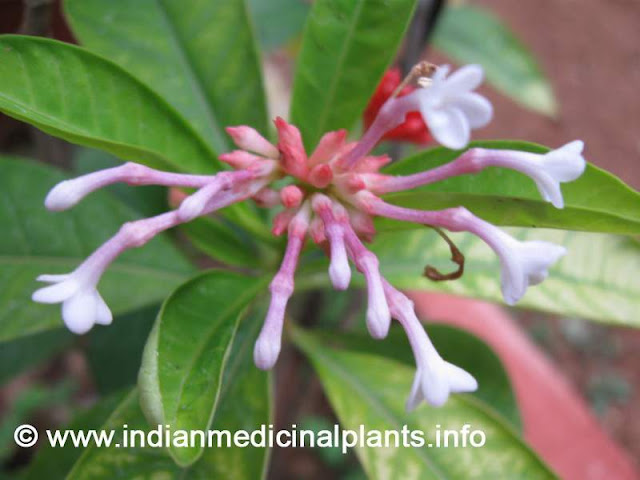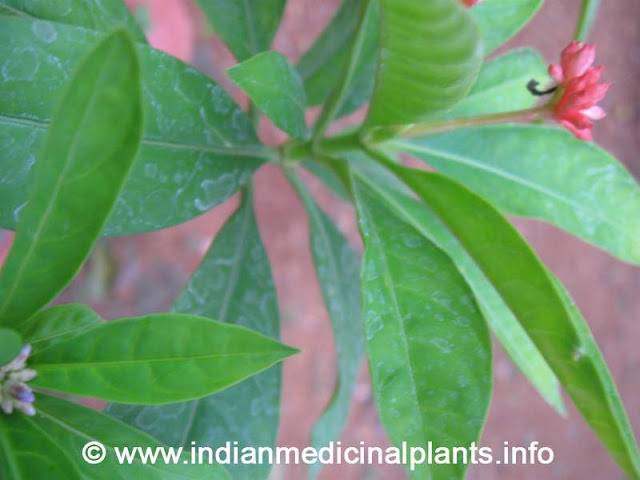Rauwolfia serpentina - Sarpagandha- snakeroot
It is one of the 50 fundamental herbs used in traditional Chinese medicine, where it has the name shégēn mù (Chinese: 蛇根木) or yìndù shémù (Chinese: 印度蛇木). Rauwolfia serpentina contains a number of bioactive chemicals, including yohimbine, reserpine, ajmaline, deserpidine, rescinnamine, serpentinine.

The extract of the plant has also been used for millennia in India — Alexander the Great administered this plant to cure his general Ptolemy of a poisoned arrow. It was reported that Mahatma Gandhi took it as a tranquilizer during his lifetimeA compound which it contains called reserpine, is used to treat high blood pressure and mental disorders including schizophrenia, and was particularly popular for that purpose in the West from 1954 to 1957.
It has been used for millennia as an antidote against bites of venomous reptiles

Principal Constituents Reserpine is the most important alkaloid present in root, stem and leaves of the plant. It varies from 1.7 to 3.0 %. The root barks has more than 90% of the total alkaloids in roots. The % of the alkaloid depends on the geographical place from where the plant is collected and also the season of collection. Generally samples from Assam have a higher % of alkaloids (2.57 %) than the other parts of India and December is the best month for the collection for getting more % of alkaloids. But, age of the plant has no effect on the % of alkaloid content (up to 4 years). Ajmalicine, ajmaline, isoajmaline, ajmalinine, chandrine, rauwolfinine, renoxidine, rescin-namine, reserpiline, reserpin, reserpinine, sarpagine, serpentine, serpentinine, tetraphyllicine, yohimbine, 3-epi-a-yohimbine are the minor alkaloids identified from samples collected from India.
Pharmacology
Reserpine has a highly complex pattern of activity. Besides the amine concentration in brain, it is also reported to influence the concentration of glycogen, acetyl choline, g-amino butyric acid, nucleic acids and anti-diuretic hormone. The effects of reserpine include respiratory inhibition, stimulation of peristalsis, myosis, relaxation of nictating membranes, and influence on the temperature regulating centre. It increases the volume and free acidity of gastric secretion. Reserpine reduces glycaemia in some cases but the effect is short-lived. In some patients it has a stimulating effect on prothrombin activity. Reserpine also favors permeation of blood into areas rendered ischemic by burns1. It produces sedation and a lowering of blood pressure. If administered orally, in hypertension, the effects of reserpine are slow, seldom appearing before 3-6 days of administration and continuing for some time after withdrawal of the drug and have a cumulative effect. It is most valuable in young patients with mild labile hypertension associated with tachycardia. In long established hypertension, it is best used in conjunction with more potent hypertensive drugs such as hexamethonium or hydralazine. Combined with polythiazide, it is a useful hypotensive in mild to moderate thiazide, it is a useful hypotensive in mild to moderate conditions. The response to reserpine varies in patients and the dosage must be adjusted to individual requirements. In severe hypertension, it may be given by intravenous or intramuscular injection when the effect begins within a few hours. Parenteral therapy of reserpine is indicated in the treatment of hypertension only when oral administration is impracticable

Toxicology
In patients with cardiac arrhythmia, myocardial infarction or severe cardiac damage, bronchitis, asthma or gastric ulcer, reserpine has a relatively low toxicity, but even the minimum therapeutic doses may give rise to nasal congestion, lethargy, drowsiness, peculiar dreams, vertigo and gastro-intestinal upsets; sometimes dyspnea and urticarial rash may occur. Higher doses may cause flushing, injection of conjunctivae, insomnia, bradycardia, occasionally parkinsonism, and severe mental depression which may lead to suicide. Cases of asthenia and edema have also been reported. Side effects of reserpine are usually transient and quickly disappear on reducing the dosage or discontinuing treatment. Tolerance to reserpine does not develop and it does not appear to be habit-forming. Prolonged previous use of reserpine may cause disturbances in blood pressure during operation under general anesthesia, while some patients may be highly susceptible to a small parenteral dosage. When give to nursing mothers to increase the secretion of milk, it is excreted with milk but the amount is not therapeutically harmful3. Minimum therapeutic doses may give rise to nasal congestion, lethargy drowsiness, peculiar dreams, vertigo and gastro-intestinal upsets; sometimes dyspnea and urticarial rash may occur. Higher doses may cause flushing, injection of conjunctivae, insomnia, bradycardia, occasionally parkinsonism, and severe mental depression which may lead to suicide. Cases of asthenia and edema have also been reported. Side effects of reserpine are usually transient and quickly disappear on reducing the dosage or discontinuing treatment. Serpentine is more toxic than ajmaline or serpentinine.